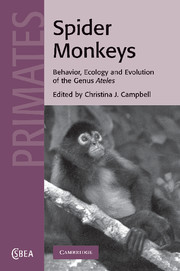Book contents
- Frontmatter
- Contents
- List of contributors
- Acknowledgements
- 1 Introduction
- Part I Taxonomy, phylogeny and evolution
- 2 Morphology and evolution of the spider monkey, genus Ateles
- 3 The taxonomic status of spider monkeys in the twenty-first century
- Part II Ecology
- Part III Behavior and reproduction
- Part IV Interactions with humans
- Index
- References
2 - Morphology and evolution of the spider monkey, genus Ateles
Published online by Cambridge University Press: 05 May 2010
- Frontmatter
- Contents
- List of contributors
- Acknowledgements
- 1 Introduction
- Part I Taxonomy, phylogeny and evolution
- 2 Morphology and evolution of the spider monkey, genus Ateles
- 3 The taxonomic status of spider monkeys in the twenty-first century
- Part II Ecology
- Part III Behavior and reproduction
- Part IV Interactions with humans
- Index
- References
Summary
Introduction
Spider monkeys cast a distinct morphological silhouette – long scrawny arms and a snaky prehensile tail arching from a narrow pot-belly torso, topped by a small round head and blunt face. The commitment of this relatively large-bodied platyrrhine to a large-tree, upper canopy milieu and to ripe fruit foraging is seen throughout its skeletal and craniodental morphology. Spider monkeys are the signature New World suspensory-postured brachiators. Bodily, they are the closest thing to a gibbon that has evolved anywhere else within the Order Primates. Less obvious may be the fact that they are also gibbonesque craniodentally. But in the context of the adaptive array of Latin America's four ateline genera, Alouatta, Lagothrix, Brachyteles and Ateles, spider monkeys are not simply the polar end of an adaptive morphocline, standing opposite howlers or even opposite Lagothrix if we draw our comparison more narrowly, to encompass only atelins. Spider monkeys are different by far. For example, as close as Brachyteles is to the visage of a spider monkey with its ungainly limbs and shortness of face, it does not match Ateles in the high-energy lifestyle that goes along with eating quickly metabolized fruit and little else. Nor can Brachyteles deftly fly and lope through the trees as if gravity and substrate did not matter and hands, feet and tail were octopus tentacles. How ironic that Geoffroy Saint-Hilaire was so impressed with the spider monkey's lone anatomical “deficiency,” its missing thumb, that in 1806 he named the genus Ateles, meaning imperfect.
- Type
- Chapter
- Information
- Spider MonkeysThe Biology, Behavior and Ecology of the Genus Ateles, pp. 19 - 49Publisher: Cambridge University PressPrint publication year: 2008
References
- 18
- Cited by



